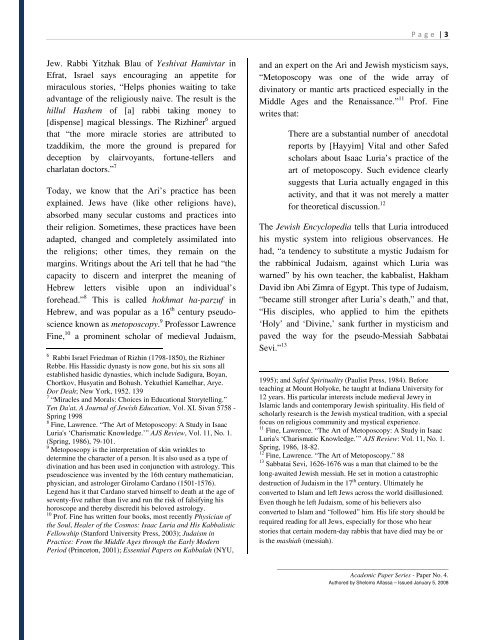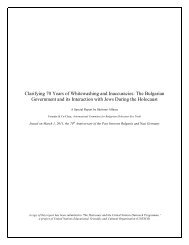Fortune Telling and Palm Reading are Not Part of Judaism - Alfassa
Fortune Telling and Palm Reading are Not Part of Judaism - Alfassa
Fortune Telling and Palm Reading are Not Part of Judaism - Alfassa
Create successful ePaper yourself
Turn your PDF publications into a flip-book with our unique Google optimized e-Paper software.
Jew. Rabbi Yitzhak Blau <strong>of</strong> Yeshivat Hamivtar in<br />
Efrat, Israel says encouraging an appetite for<br />
miraculous stories, “Helps phonies waiting to take<br />
advantage <strong>of</strong> the religiously naive. The result is the<br />
hillul Hashem <strong>of</strong> [a] rabbi taking money to<br />
[dispense] magical blessings. The Rizhiner 6 argued<br />
that “the more miracle stories <strong>are</strong> attributed to<br />
tzaddikim, the more the ground is prep<strong>are</strong>d for<br />
deception by clairvoyants, fortune-tellers <strong>and</strong><br />
charlatan doctors.” 7<br />
Today, we know that the Ari’s practice has been<br />
explained. Jews have (like other religions have),<br />
absorbed many secular customs <strong>and</strong> practices into<br />
their religion. Sometimes, these practices have been<br />
adapted, changed <strong>and</strong> completely assimilated into<br />
the religions; other times, they remain on the<br />
margins. Writings about the Ari tell that he had “the<br />
capacity to discern <strong>and</strong> interpret the meaning <strong>of</strong><br />
Hebrew letters visible upon an individual’s<br />
forehead.” 8 This is called hokhmat ha-parzuf in<br />
Hebrew, <strong>and</strong> was popular as a 16 th century pseudoscience<br />
known as metoposcopy. 9 Pr<strong>of</strong>essor Lawrence<br />
Fine, 10 a prominent scholar <strong>of</strong> medieval <strong>Judaism</strong>,<br />
6 Rabbi Israel Friedman <strong>of</strong> Rizhin (1798-1850), the Rizhiner<br />
Rebbe. His Hassidic dynasty is now gone, but his six sons all<br />
established hasidic dynasties, which include Sadigura, Boyan,<br />
Chortkov, Husyatin <strong>and</strong> Bohush. Yekuthiel Kamelhar, Arye.<br />
Dor Deah; New York, 1952. 139<br />
7 “Miracles <strong>and</strong> Morals: Choices in Educational Storytelling.”<br />
Ten Da'at, A Journal <strong>of</strong> Jewish Education, Vol. XI. Sivan 5758 -<br />
Spring 1998<br />
8 Fine, Lawrence. “The Art <strong>of</strong> Metoposcopy: A Study in Isaac<br />
Luria's ‘Charismatic Knowledge.’” AJS Review, Vol. 11, No. 1.<br />
(Spring, 1986), 79-101.<br />
9 Metoposcopy is the interpretation <strong>of</strong> skin wrinkles to<br />
determine the character <strong>of</strong> a person. It is also used as a type <strong>of</strong><br />
divination <strong>and</strong> has been used in conjunction with astrology. This<br />
pseudoscience was invented by the 16th century mathematician,<br />
physician, <strong>and</strong> astrologer Girolamo Cardano (1501-1576).<br />
Legend has it that Cardano starved himself to death at the age <strong>of</strong><br />
seventy-five rather than live <strong>and</strong> run the risk <strong>of</strong> falsifying his<br />
horoscope <strong>and</strong> thereby discredit his beloved astrology.<br />
10 Pr<strong>of</strong>. Fine has written four books, most recently Physician <strong>of</strong><br />
the Soul, Healer <strong>of</strong> the Cosmos: Isaac Luria <strong>and</strong> His Kabbalistic<br />
Fellowship (Stanford University Press, 2003); <strong>Judaism</strong> in<br />
Practice: From the Middle Ages through the Early Modern<br />
Period (Princeton, 2001); Essential Papers on Kabbalah (NYU,<br />
P a g e | 3<br />
<strong>and</strong> an expert on the Ari <strong>and</strong> Jewish mysticism says,<br />
“Metoposcopy was one <strong>of</strong> the wide array <strong>of</strong><br />
divinatory or mantic arts practiced especially in the<br />
Middle Ages <strong>and</strong> the Renaissance.” 11 Pr<strong>of</strong>. Fine<br />
writes that:<br />
There <strong>are</strong> a substantial number <strong>of</strong> anecdotal<br />
reports by [Hayyim] Vital <strong>and</strong> other Safed<br />
scholars about Isaac Luria’s practice <strong>of</strong> the<br />
art <strong>of</strong> metoposcopy. Such evidence clearly<br />
suggests that Luria actually engaged in this<br />
activity, <strong>and</strong> that it was not merely a matter<br />
for theoretical discussion. 12<br />
The Jewish Encyclopedia tells that Luria introduced<br />
his mystic system into religious observances. He<br />
had, “a tendency to substitute a mystic <strong>Judaism</strong> for<br />
the rabbinical <strong>Judaism</strong>, against which Luria was<br />
warned” by his own teacher, the kabbalist, Hakham<br />
David ibn Abi Zimra <strong>of</strong> Egypt. This type <strong>of</strong> <strong>Judaism</strong>,<br />
“became still stronger after Luria’s death,” <strong>and</strong> that,<br />
“His disciples, who applied to him the epithets<br />
‘Holy’ <strong>and</strong> ‘Divine,’ sank further in mysticism <strong>and</strong><br />
paved the way for the pseudo-Messiah Sabbatai<br />
Sevi.” 13<br />
1995); <strong>and</strong> Safed Spirituality (Paulist Press, 1984). Before<br />
teaching at Mount Holyoke, he taught at Indiana University for<br />
12 years. His particular interests include medieval Jewry in<br />
Islamic l<strong>and</strong>s <strong>and</strong> contemporary Jewish spirituality. His field <strong>of</strong><br />
scholarly research is the Jewish mystical tradition, with a special<br />
focus on religious community <strong>and</strong> mystical experience.<br />
11 Fine, Lawrence. “The Art <strong>of</strong> Metoposcopy: A Study in Isaac<br />
Luria's ‘Charismatic Knowledge.’” AJS Review: Vol. 11, No. 1.<br />
Spring, 1986, 18-82.<br />
12 Fine, Lawrence. “The Art <strong>of</strong> Metoposcopy.” 88<br />
13 Sabbatai Sevi, 1626-1676 was a man that claimed to be the<br />
long-awaited Jewish messiah. He set in motion a catastrophic<br />
destruction <strong>of</strong> <strong>Judaism</strong> in the 17 th century. Ultimately he<br />
converted to Islam <strong>and</strong> left Jews across the world disillusioned.<br />
Even though he left <strong>Judaism</strong>, some <strong>of</strong> his believers also<br />
converted to Islam <strong>and</strong> “followed” him. His life story should be<br />
required reading for all Jews, especially for those who hear<br />
stories that certain modern-day rabbis that have died may be or<br />
is the mashiah (messiah).<br />
_____________________________________________________<br />
Academic Paper Series - Paper No. 4.<br />
Authored by Shelomo <strong>Alfassa</strong> – Issued January 5, 2008



